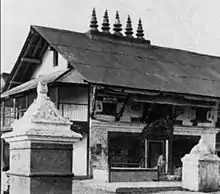Te Bahal
Te Bahal (also called Raja Kirti Mahavihar) is the largest bahal in Kathmandu, Nepal. It is home to the deity Sankata, worshiped by both Hindus and Buddhists.[1]
| Te Bahal | |
|---|---|
 Sankata Temple in the 1960s | |
| Location | Kathmandu, Nepal |
| Coordinates | 27°42′8.16″N 85°18′44.09″E |
Unlike other Bahals andu, Te Bahal has two dyochhes (houses for gods) indicating the existence of two bahals that were later merged into one.
History
Legend has it that during the rule of the Malla King, Narendra Dev, a Gubhajyu, a Buddhist sorcerer skilled in tantric practices, called Bandhu Ratna Bajracharya, with permission from the king, used his tantric powers and brought Sankata and Yogini into three different holy pitchers and worshiped them. Later, a temple for the goddess was established during the reign of King Gunakama Dev. To this day, every 12 years, a Buddhist priest gubhajyu from the temple of the Newar Bajracharya clan, worships the goddess in a holy pitcher along with another pitcher for Yogini at the Katuwal Daha at Chobhar and then the goddesses are enshrined in the temple.
According to cultural expert Indra Mali, who grew up in Te Bahal, Sankata is not originally from Kathmandu. A legend states that Palah: Dya, as Buddhists call the deity, was brought from Kamaru Kamachya (the present Kamakhya) in Assam. Palah: Dya later became widely known as Sankata.
Rituals and festivals
The deity is worshipped by following secret tantric rituals. The priest must not be touched at the temple, nor must the statue of the goddess. The statue of the goddess is draped in cloth covering her body except for her head. Devotion to Sankata is commonly believed to ward off troubles and bad omens from one's life. Although religious rites are carried out every day, the temple is frequented mostly on Saturdays, or one's birthday. Everything required for worship is available right outside the temple. One can also ask the priests to do some puja for placating one's unfavorable planets and stars. For that, one would have to have oil, iron, black cloth, and black lentils. Every 12 years, the priest of the temple, a Buddhist Gubhaju of the Newar Bajracharya clan, worships the goddess in a holy pitcher along with another pitcher for Yogini at the Katuwal Daha at Chobhar and then the goddesses are enshrined in the temple.
References
- "The Temple of Sankata". Boss Nepal. Retrieved 2019-09-13.